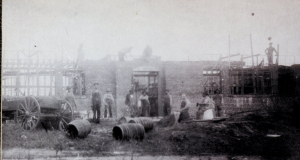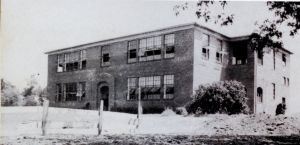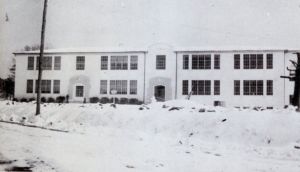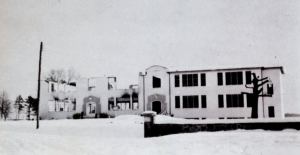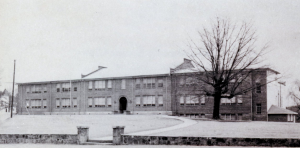Mill Spring Agricultural Development and Community Center History
The Mill Spring School was donated to the Polk County Soil and Water Conservation District in December 2009. An anonymous donor gave $1 as the first donation to the Center and that first dollar is framed at the Ag Center.
Mill Spring School History
1921 – Mill Spring started in a new brick building. Barefoot consolidated with Mill Spring.
1923 – Pea Ridge consolidated with Mill Spring
1924 – Mr. Lingerfelt was Principal and Mr. E.W. Cobb was superintendent.
1925 – Mill Spring was formally recognized as a High School.
1931 – Silver Creek consolidated with Mill Spring
1933 – Some records show that the class of ’33 was first to receive diploma from Mill Spring High School. Mr. Bill Nesbitt was Principal and Mr. H.W. McDonald was assistant.
1934 – Mr. McDonald became Principal. In the middle of the thirties, the high school had to go to Stearns. Mr. McDonald and citizens of the community fought to have the students returned to Mill Spring.
1938 – The students were reinstated.
1940 – In January, the North wing of the school was destroyed by fire. the high school had to go to Stearns for two years. The lower grades attended classes in the remaining South Wing, Teacherage, and Methodist Church.
1940 – Under the leadership of Mr. McDonald, a new building was erected by the W.P.A.
1942 – The class of 1942 was first to graduate from renovated school.
1943 – Mr. J.W. Gantt took Mr. McDonalds place as principal. He served only 2 years.
1945 – Mr. Stanley L Walkerowicz became Principal.
1946 – The 12th Grade was added. No graduating class that year.
1947 – The class of 1947 was the first class to go 12 years.
1948 – Sunny View lost their high school and consolidated with Mill Spring. The first class from Sunny View to graduate at Mill Spring.
1960 – Mill Spring gave the last diplomas to the class of 1960.
1961 – Mill Spring became a grammar school.
1969 – The first year of integration.
1972 – Mill Spring became an elementary school.
1992-93 – Mill Spring School closed its doors.
History of Mill Spring, NC
Mill Spring Agricultural Center resides in Mill Spring, NC but the history of our hamlet is well worth retelling again and again. Mill Spring was founded by Ambrose Mills with his wife Mourning Stone Mills. They had a son, William Mills, born on November 10, 1746. Born in Virginia, the Mills were among settlers growing tobacco. England became jealous of this rich crop being grown in the New World and passed a law that tobacco could only be sold to England and at a fixed price. This price was well below what was the crop was worth, and the law resulted in an economic depression for Virginia farmers. In 1766, the Mills left Virginia to find a new home. They finally came to rest near a bold gushing spring which we know now as Mill Spring.
After the Revolutionary War started, Ambrose Mill and his son William were commissioned in the Tory militia and went throughout the Piedmont of North Carolina rallying troops to support the Crown. A Major Ferguson was sent to rally the Tories in the upcountry and issued a proclamation, “Join my forces or I will come to you; hang your leaders, burn your homes and lay waste to your land.” This was a terrible mistake because up until this point, mountain settlers had not become involved in supporting the revolution for either side. This statement brought together these men and they started a march towards Ferguson. Their path is now known as the Overmountain Victory Trail. The Overmountain Men attacked Major Ferguson who then retreated to Kings Mountain during the fight. At King’s Mountain with Major Ferguson were Ambrose and William Mills. On October 7, 1780, the Mountain Men in just about an hour’s time killed or wounded all of the Tory opposition. Thomas Jefferson said of this victory, that it “turned the tide of success” in the Revolutionary War. Ambrose Mills was hung after the fight but William Mills was able to escape even though he suffered bullet and saber wounds. William dragged himself to a cave quite a distance from King’s Mountain and with leaves for a bed he survived on wild fruit and game. The mountain he hid upon was Sugar Loaf Mountain.
When his wounds finally healed, William Mills emerged from the woods to find a different world. He learned of his Father’s death and that the war was over and America was born. All of the land owned by his father and himself had been confiscated by the government. So again, the Mills moved and made their way slowly up the mountain by blazing a trail which became known as Mills Gap and continues to serve as a road in Henderson County today. The Mills came upon a bold spring of cold, pure, sweet mountain water which is where they ended up settling as the first white people to settle permanently in what is no known as Henderson County. William Mills prospered after that arduous journey and began farming and planting. In particular, he planted apple trees. William Mills became the father of the apple industry in Henderson County and the founder of Mills River.
The history is taken from the book, “From the Banks of the Oklawaha” by Frank L Fitzsimmons. Thanks to Peter Barr for his resourcefulness in finding this information.
